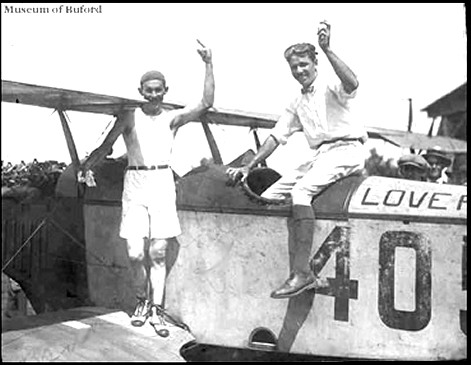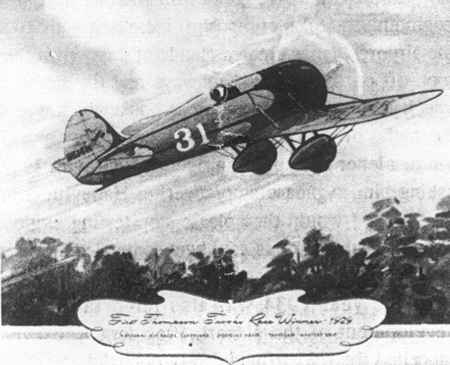
1900-1934 AKA Douglas H. Davis |
 |
from History of Hapeville, Georgia Courtesy of Bill McElhannon, 1-12-07 |
extract from History of Hapeville, Georgia Courtesy of Bill McElhannon, 1-12-07 Doug came from Zebulon, Georgia. He volunteered as an Army Pilot and received his commission in 1917, at 17 years of age. He resigned from the Army in 1919. In the late teen's and early 20's, the most barnstorming money could be made in the northeast. Davis organized a unit which barnstormed New York City and adjacent areas. The Mabel Cody Flying Circus came south and gave Doug's group some fierce local competition. Doug merged with the Cody Flying Circus and performed primarily in Florida through 1923. In 1924, he formed a unit of the Baby Ruth Flying Circus to advertise the new candy bar introduced that year. Doug assisted William B. Hartsfield in every way he could to influence Atlanta in selecting the old speedway as the Atlanta Airport. Doug married on December 25, 1925, and they barnstormed most of 1926. In 1926 or early 1927, he contstructed the first permanent airport hangar on the old speedway grandstand area. The early hangars were about 50x100 feet. Later in 1927 he moved his hangar near the other two, which were located adjacent to the newly graded landing field. Doug operated the Doug Davis Flying Service, a school of aviation, was a Waco plane distributor, and continued to operate a unit of the Baby Ruth Flying Circus. Davis became a race pilot at the two-day Atlanta Air Races in 1928, winning first or second place in all events. By 1928, he had also switched from Waco to Travel Air distributor." Editor's Note:You can read the rest of his story in the book, History of Hapeville. You may be able to find a few copies for sale by searching the net. There may also be a copy available through your library. The article offers several other photographs and stories of other notable pioneer aviators. |
 |
late 1920's from the Museum of Buford Courtesy of Lynn A. Bowman, 10-11-07 |
|
2 WHEREAS, pioneer pilot Doug Davis, trained under the 3 direction and guidance of Wilbur (1867-1912) and Orville 4 (1871-1948) Wright, American aviational pioneers, with the 5 first powered flight. During this time he became a friend 6 to these giants of American history, and Orville Wright 7 signed Doug's pilot's certificate; and 8 WHEREAS, Doug Davis, had a flying circus, thrilling 9 people with stunts such as wing walking and parachute 10 jumping. One stunt involved picking up Bonnie Rowe, his 11 parachute jumper, from the top of a fast moving train. By 12 the time Doug had done this stunt, he had joined the flying 13 circus of Mable Cody, who was the niece of Buffalo Bill 14 Cody; and 15 WHEREAS, Doug was Eastern Airlines' first captain and no 16 stranger to the boys who started Delta Airlines. Doug also 17 flew the first commercial airline flight from Atlanta to New 18 York, and in the National Air and Space Museum in 19 Washington, D.C., his statue stands by "Eddie" Rickenbacker 20 (1890-1973), American aviator, World War I ace flyer, and 21 businessman; and 22 WHEREAS, Doug opened the first hangar on Candler Field; by 23 that, he offered Atlanta's first air training school and the 24 first charter service. Today, from that very spot, one can 25 look a short distance and view the big jets as they come and 26 go from the William B. Hartsfield Atlanta International 27 Airport. Doug saw the vision of the Atlanta airport as a 28 crossroads to the world, and on his field, Doug offered a 29 clay runway where his friend, Colonel Charles A. Lindbergh, 30 came through. 31 NOW, THEREFORE, BE IT RESOLVED BY THE HOUSE OF 32 REPRESENTATIVES that the members of this body dedicate to 33 Doug Davis, to the aviational pioneers, and to all 34 pilots these words from "Come Fly Away," written by poet 35 Hugh Arnold: LC 19 4758 1 There's a place high above, 2 Where eagles dare not soar- 3 Where pilots sail the skies, 4 Gleaning sights to adore. 5 High in the lofty heights, 6 There's a peace that's serene- 7 Where God paints pictured clouds, 8 And angels do convene. 9 Come fly away with me, 10 And leave the world behind- 11 Just set your sights toward God, 12 And let your soul unwind. 13 Up here the world's at peace 14 And nothing's out of place. 15 It's a world of pure blue, 16 With never ending space. 17 BE IT FURTHER RESOLVED that the Clerk of the House of 18 Representatives is authorized and directed to transmit an 19 appropriate copy of this resolution to Doug Davis, Sr. |
 |
a Travelair Special "Mystery Ship." from History of Hapeville, Georgia Courtesy of Bill McElhannon, 1-12-07 |
from Bill Taylor, 12-13-07 I am Doug Davis' Great Nephew, I enjoyed your web site so much. Several years ago I was able to meet General Paul Tibbets as his niece worked at the Georgia State Patrol Office here in Griffin GA. (I own and operate two radio stations here and have coordination with the State Patrol on a daily basis. One day while we were disusing world war II she advised me that her uncle was Paul Tibbets that dropped the atom bomb during the war. While in the military I did a information paper in one of my classes on General Tibbets. I was given a book by him that when I was reading one evening Found that uncle Doug had given Tibbets his first airplane ride when he dropped Curtis candy bars at the race track in Florida. Tibbets father at the time was a candy distributor. The entire story is in Tibbets book. I recently managed to get a print you show in your web site of Doug taking off in the Travel Air. Any additional information you may have on my Great Uncle would be greatly appreciated. Aunt Glenna Mae passed away a few years ago and I remember so well as a young boy talking to her about Doug and uncle Paul Davis who was also a pilot and flew B-24s in the Polesti Oil Field Raid from North Africa in world War II. Their Brother Howard was my Grandfather, he lived in Pike County and ran a farm and auto businesses during the remainder off his life. Thank you for your time and considerations. Bill Taylor LTC (R) USA, |
from Bill Taylor, 9-9-09 I am very interested in my great uncle's information you may have. There is a great family friend who is building an exact copy of the original Candler Field Airport (now Atlanta International Airport), as Doug had the first hangar at the old Atlanta Airport, the copy and museum is being built close to our home in Williamson Georgia at the small airport there. The first phase is complete with the hanger for the museum aircraft, other items of the 1920s. Doug's original hanger will be built next. Also a great restaurant, has been added and they are very successful with the venture. We have loaned the museum many photos etc of Doug and his history. Doug's only survivor is his daughter, Darlene, who lives in Newnan, Georgia. I had a chance to meet Paul Tibbets before his death as Paul had mentioned Uncle Doug in his book (chapter three) as the first individual to give Tibbets an air plane ride. Tibbets father at the time was a huge candy distributor in Miami Florida and Tibbets took a ride with Uncle Doug who worked also with Curtis Candy Company and developed a parachute to float Baby Ruth candy bars to visitors of races, and gatherings as publicity for Curtis Candy. Doug had several brothers, one Paul Davis, was in the Polesti Oil Field raids from North Africa at the beginning of world war II. Paul stayed in the air force reserve and commanded several bomber wings. As you are aware Doug was killed in the 1934 Thompson Trophy, and won the 1929 (first race) when he flew the travel air mystery ship to finish ahead of the military pilots. I recently found a lithograph of Doug taking off on that day that was sponsored by Thompson to commemorate all winners of the race in the 1940s. This one is very near to my heart and has a special place in our family. My dad was able to acquire some of the debris of the crash many years ago, but we are interested and would cherish the items you have. Please advise. Thank you so very much,. Bill Taylor LTC (R) USA Griffin GA |
|
|
|
|
|
"Although the military had dominated the Pulitzer and Schneider races, civilian pilots and homebuilt planes tended to excel in the Thompson contest. In 1929, Doug Davis shocked everyone when he piloted a Travel Air Model R "Mystery Ship" to victory over the best the military had. " You can access it by clicking on the title above., |
|
|
from Bob Davis, 1-1-07 Can't find my copy of Donald W. Dwiggins, [The Air Devils] or [The Barnstormers: Flying Daredevils of the Roarting Twenties]. but as I remember they both tell quite a bit of Davis' accomplishments. A good source is Robert Hull's [September Champions, The Story of America's Air Racing Pioneers] 1979 223 page book, ISBN 0-8117-1519-1 by Stackpole Books, Harrisburg, PA. The whole Chapter 5 "If Only Doug Can Get through Monday" is about Doug Davis, Sr. |
via email from William Webster, 8-3-08 Thanks. William Webster |
response from Ralph Cooper, 8-23-08 Here is what I found when I searched using Google on "Doug Davis" +1936 +aviation. "In 1934 the Depression had cut the purses and the show had shrunk to a Labor Day weekend festival, similar to todayís Air Show. It was also in 1934 that the first closed-course racer, Doug Davis, went down. Davisís death allowed Roscoe Turner, the flamboyant barnstormer, to win his first Thompson Race. Turner returned the next year, losing the Bendix race from Los Angeles to Cleveland by 23 seconds to Benny Howard. Turner vowed to win the Thompson Race, which had been increased, to 10 laps around a 15-mile course. Over 85,000 spectators watched Turner lead the race for eight laps. Then the blade on his Hornet engine snapped off. In a split second decision, Turner landed the smoking plane with a couple of bounces in front of the finish line stealing the show." I found this on: http://www.clevelandairshow.com/press_room/natlairraces.htm Maybe you can find what plane he was flying by a more detailed search. Good luck, Ralph |
via email from William Webster, 8-27-08 Thanks for your info. I did some more searching and learned that Doug and Roscoe were each flying a Wedell Williams 44. Turner's was painted a silver gray and numbered 57 after the Heinz Co. who sponsored him. Doug 's was red and black - which is what I remembered. I got a picture from searching "Wedell-Williams aircraft". For a long time I had a small piece of the red fabric. Only difference was that the plane was either open cockpit or someone had slid the canopy back. |
|
"Davis died in the 1934 Thompson Air Race at Cleveland, OH on the Labor
Day weekend when he pulled up to try again to circle a pylon he had missed.
The plane did a high-speed stall and slammed into the ground and he was
killed instantly. " Editor's Note: If you have any more information on this pioneer aviator, please contact me. E-mail to Ralph Cooper Back 

|